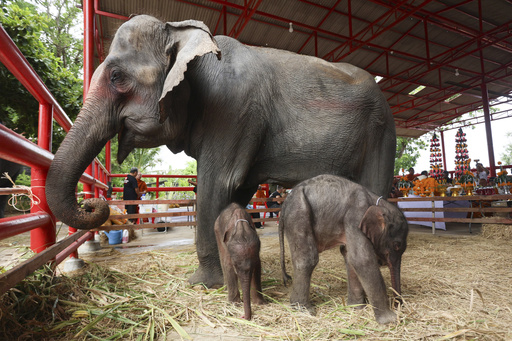BANGKOK (AP) — Buddhist monks in Thailand on Friday blessed twin baby elephants, one male and the other female, a week after their rare birth came close to being a tragedy.
Their mother, Chamchuri, gave birth to the pair on the night of June 7 at a camp in Thailand’s ancient capital Ayutthaya, a popular tourist destination 80 kilometers (50 miles) north of Bangkok.
Twin elephant births are rare and male-female twins even more so. The Ayutthaya Elephant Palace & Royal Kraal, home to the newborns, says that it was a first for the province, while a statement from the Thai government said they were the third such pair in the world.
The two are the 30-year-old mother elephant’s fourth and fifth offspring.
Caretakers at the elephant camp had been expecting to help deliver a baby, but when a second offspring dropped from her mother’s womb 18 minutes afterward, they were shocked.
The elephant caretakers, who are called mahouts in Asia, had to act quickly to prevent the equally startled mother from accidentally injuring her new daughter.
One of the mahouts, Charin Somwang, broke his leg when he stepped between the mother and her offspring to prevent the tragedy. He told Thailand’s Daily News newspaper that it is normal for a mother elephant to step on and gently prod after birth to check if it is alive. But the second baby, the female, appeared too weak to sustain that kind of treatment, he said.
On Saturday, Charin was discharged from the hospital and was thrilled to discover that both babies were healthy.
Monks from Wat Traimit in Bangkok came to bless the twins on Friday as part of merit-making ceremonies for the occasion. Afterward, the calves were presented with a tray of bananas and cartons of milk.
Elephants are a big part of Thailand’s national identity and have been officially proclaimed a symbol of the nation. Thai kings rode elephants into battle and a white elephant, considered a sacred symbol of royal power, adorned the Thai flag until 1917.
Once essential to the logging trade, deforestation left many elephants without jobs, and while a shrinking population of wild ones roam the remaining forests, many are kept at animal shelters or used as living props at tourist sites.
This website uses cookies so that we can provide you with the best user experience possible. Cookie information is stored in your browser and performs functions such as recognising you when you return to our website and helping our team to understand which sections of the website you find most interesting and useful.
